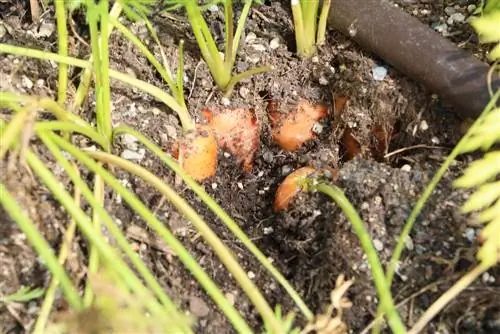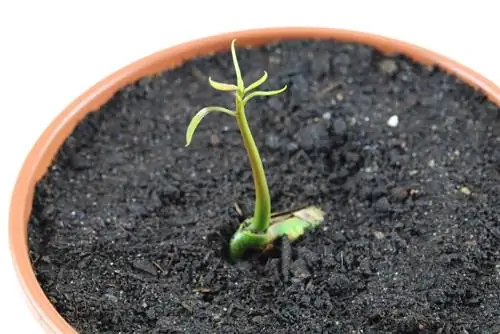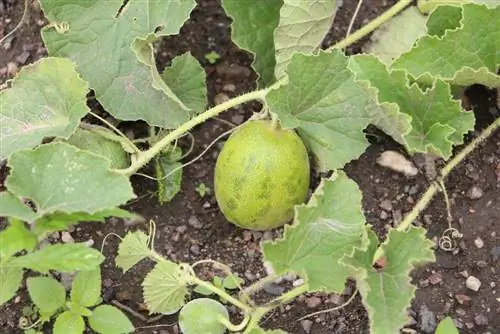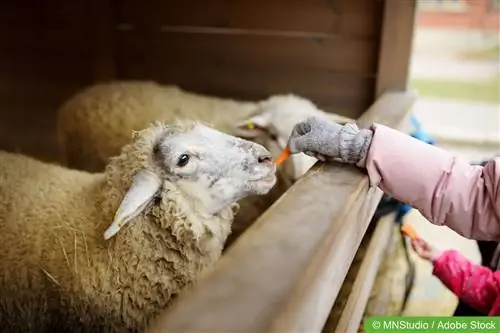- Author admin [email protected].
- Public 2023-12-17 03:39.
- Last modified 2025-01-24 12:45.
The carrots are still easy to sow and care for - but until harvest, numerous pests and diseases can cause them problems and noticeably reduce the yield. To ensure that the initial work is worthwhile and that the carrots end up on your own plate instead of as food for parasites, there are a few factors that need to be taken into account. But if you make this effort, you can not only look forward to a large harvest, but also grow carrots more easily in the future. And even on the balcony.
Location
Lots of sun and occasional wind are particularly good for carrots. The sun ensures a warm soil and good growth, while the wind drives away many parasites from the bed. Raised beds are a good choice if the ground is rather cold or there is a dense windbreak provided by other plants. These are also recommended because the clear demarcation makes the cultivation sequence easier.
Substrate
The substrate for growing carrots must be permeable, deeply loose and nutrient-rich. The soil can definitely be clayey, but then it has to be loosened up by adding sand. Caution is advised if the bed for the carrots is located directly next to water or in a depression. The root vegetables like a constantly moist substrate, but they don't like moisture. If rain or overflow from the pond and barrel cannot drain away quickly, the harvest is in danger.
Nevertheless, normal garden or plant soil is completely sufficient as a base. In any case, the substrate must be prepared accordingly for growing carrots.
Preparation of the bed
Before carrot cultivation can begin, the bed must be prepared appropriately for the he althy vegetable. This involves several steps:
- Fertilize sufficiently in the fall before cultivation. Well-rotted compost, manure or horn meal are ideal.
- Use a spade for substrates that tend to compact or are clayey. Deep loosening of twice the length of the spade or a depth of 30 to 50 centimeters is necessary so that, on the one hand, the water can drain away and, on the other hand, the roots can spread easily. This measure also ensures that the fertilizer is distributed more evenly.
- If the soil is still solid, sand or gravel must be added.
- Finally, a thick layer of mulch is applied to protect against weeds. Lawn clippings are best suited for this purpose and can be spread on the ground immediately after mowing.
The bed has to rest over the winter. The nutrients from the fertilizer are distributed and settle slightly.
variety selection
While the bed over the Witer becomes the ideal breeding ground for growing carrots through natural processes, hobby gardeners have time to choose the variety. A basic distinction is made here between storage carrots and early carrots. If you want to harvest in May or June, you should choose the early varieties. For a supply of vitamin A, root vegetables and carrots are sufficient in autumn and winter.
Early carrot varieties
- Nantaise breeds, such as Bolero F1 or Flyaway F1
- Purple Haze
- Purple Sun
- Red Samurai
- Caracas
Carrot varieties suitable for storage:
- Red Giant
- Long Red Blunt (without heart)
- Hilmar
- Ingot
- Yellowstone
Tip:
It's worth not just taking a look at the usual orange carrots - the colorful varieties can be just as resistant, high-yielding and tasty. And they are also visually interesting.
Sowing
Depending on the variety, sowing can begin as early as February or as late as June or July. In any case, the carrot seeds are sown directly into the bed. Growing carrots indoors and then moving them is not recommended, as the roots will inevitably be injured. This can reduce the yield immensely. The carrots also tend to split. Not to mention the additional work involved.
The following procedure is recommended for growing carrots in the bed:
- 1. Draw straight lines that are 15 to 25 centimeters apart.
- 2. Plant individual seeds at a distance of three to five centimeters, place seed ribbons in the drawn depressions.
- 3. Cover the carrot seeds with a layer of soil about one centimeter thick.
- 4. Moisten the substrate well.
- 5. Cover with a layer of mulch made from grass clippings.
Tip:
Pull a ribbon or string directly over the seed lines as a marker, this will help with the following care.
Accumulation and dam culture
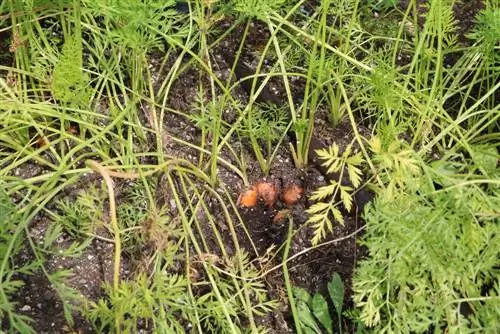
Hill cultivation, or ridge culture, is initially a less complex alternative to growing carrots. Digging can largely be avoided. Superficial loosening should only be carried out in very dense, hard soil. The carrots are then sown as described above, but there is no need to cover them with mulch. If the carrots grow out of the ground, they are repeatedly covered with soil until they are green. In this way, dams are gradually built up. The purpose of piling up is to protect the carrots from the sun and thus from turning green. The clear advantage is that there is no need for deep digging. To do this, you have to work in the bed again and again.
bed care
Especially early varieties of carrots require a lot of time to germinate. At least three weeks should be planned for this. In this phase, the young carrots are particularly susceptible to competition and quickly become overgrown. Weeding must be done early and regularly to remove weeds. Alternatively - except for the sowing line itself - the entire bed can be covered with mulch made from grass clippings. Apart from that, the following points should be taken into account when caring for carrots:
- Mark the sowing line with fast-germinating pointer seeds, such as watercress or radishes, or indicate it with a taut thread - this makes targeted weeding easier
- If you missed fertilizing the bed, you can make up for it with horn meal during or after sowing
- Cheap companion plants are onions, garlic and leeks - these keep some pests away
- Do not plant in the immediate vicinity of parsley, parsnips and other umbelliferous plants
- In the event of an infestation with pathogens or pests, immediately remove and destroy affected plants
- Keep the substrate as evenly moist as possible, but urgently avoid moisture
Growing on the balcony
If you don't have a garden, you don't have to go without fresh home-grown carrots. Some smaller varieties are suitable for this, such as:
- Nandor F1
- Adelaide
- Caracas
- Paris Market
The carrots can be grown here in pots, tubs, boxes or plant bags. The location and substrate do not differ from cultivation in the bed. The instructions already described should also be observed when watering and fertilizing. However, it is important that the vessels are sufficiently deep. In addition, piling up is recommended for balcony cultivation because it requires slightly less deep soil and less soil.
Diseases and pests
As already mentioned, some pests and diseases can be dangerous for carrot cultivation. Below:
- Bugs
- Aphids
- Carrot fly
- Butterfly caterpillars
- Rot
- Black rot
- Carrot Blackness
- Purple Rootkiller
The signs are basically similar: The carrots either show signs of being eaten or have discolored, moldy deposits. However, with a few means and measures it is quite easy to combat such infestations.
- Choose a windy location, make sure there is enough distance between the rows and the carrots themselves
- Protect seeds and plants with a vegetable net or fleece
- Create mixed cultures with onions, leeks, calendula or marigolds
- Plant carrots in the same bed only after growing other vegetables after three to four years
- Carry out regular visual inspections and if there are signs of parasites and pests, remove and destroy or bury deep underground
- Prepare the soil for growing carrots by loosening it
- Keep the substrate moist but never soak it
If these tips are taken into account, infections and damage caused by parasites can usually be effectively prevented. Of course, it is still advisable to select resistant varieties.
Conclusion
Growing carrots is easily possible in your own garden and even on your balcony if you have the necessary knowledge. The easy-care vegetable requires little work, but still requires appropriate protection against infestation by diseases and harmful insects. If the carrots are given this, nothing stands in the way of a rich harvest. Even beginners in plant care can recommend carrots.

